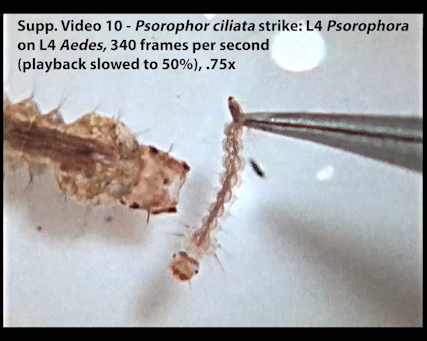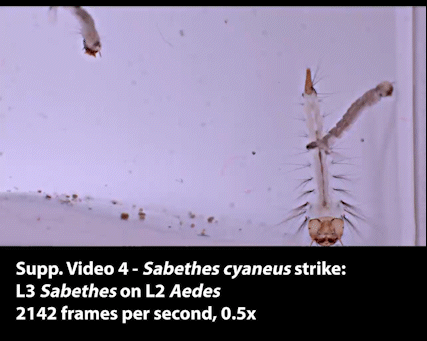Mosquito Larvae Launch Their Heads to Capture Prey
Advances in technology allowed researchers to film these cannibalistic insects hunting for the first time

Scientists have long known that predatory mosquito larvae are ferocious insect-killers with cannibalistic tendencies. But because the larvae hunt so quickly—their attack appears only as a blur to the human eye—the exact way they catch prey has evaded researchers for years.
Now, slow-motion videos taken through a microscope have captured the sophisticated hunting techniques for the first time. And their strangeness caught scientists entirely by surprise.
In a paper published in the Annals of the Entomological Society of America, researchers describe how two species of mosquito larvae “launch their heads, literally, from their bodies” to harpoon their next meal, lead author Robert Hancock, a biologist at Metropolitan State University of Denver, tells CBC’s Sheena Goodyear.
“Our jaws dropped as soon as we saw it,” Hancock says to Oliver Whang of the New York Times. “None of us could believe what we saw.”
The researchers filmed two kinds of head-harpooning mosquitoes, which elongate their necks to propel their heads forward, as well as a third species called Sabethes cyaneus that whips its tail around to guide prey into its mouth. All these species deliver their attacks in a mere 15 milliseconds.
To video the tiny killers, the team set up a camera that captures more than 4,000 frames per second. They used lights so bright and hot that the team had to apply protective filters to not “cook” the larvae, Hancock says in a statement.

Hancock first became fascinated with mosquitoes as a graduate student in the 1980s, the Times reports. One of his professors instructed him and his classmates to observe the species Toxorhynchites amboinensis under a microscope to see if they could figure out how they were hunting, per CBC. But all the students could make out was a flurry of motion followed by the larva shoveling the prey into its mouth.
In the following years, Hancock became obsessed with the mosquitoes, particularly the T. amboinensis, which he has now revealed to be one of the head-launching species, along with Psorophora ciliata.
Mosquitoes in the Toxorhynchites genus, despite their carnivorous youths, eventually lose their taste for blood and transform into enormous, nectar- and sap-eating adults. They are a possible tool for reducing mosquito-transmitted diseases, because they eat the larvae of other species and don’t bite humans. However, “their effective application has been hampered due to a lack of understanding and inconsistencies in their descriptions,” per a 2020 review on the mosquitoes published in Insects.
Knowing more about these predatory larvae could lead to more effective mosquito management techniques in the future, L.J. Zwiebel, a mosquito researcher at Vanderbilt University who was not involved in the new study, tells the Times.
Most mosquito larvae eat decaying material, so the fact that some have evolved hunting abilities is “really neat,” Daniel Peach, an entomologist at the University of Georgia who did not participate in the research, writes in an email to CBC.
“I think this research highlights that mosquitoes aren't monolithic, each species is unique and has a different niche, including in the larval stage,” he writes to the publication. “I think it's some very cool work that showcases interesting mosquito behaviors that are relatively overlooked. Aquatic predators, from sharks to insects, face some unique challenges in how they capture prey, and it is fascinating to learn more about how predatory mosquito larvae do so.”
/https://tf-cmsv2-smithsonianmag-media.s3.amazonaws.com/accounts/headshot/MargaretOsborne.png)
/https://tf-cmsv2-smithsonianmag-media.s3.amazonaws.com/accounts/headshot/MargaretOsborne.png)